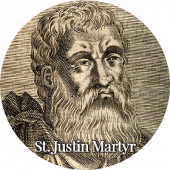
When you look into the eyes of an infant, you see someone who sees something you are no longer able to see. The orbs are clear, free of self-reflection, looking outward at the world as it really is, unclouded by disguise and interpretation. This is true even when they are looking at you – a slightly unsettling thought. Recent studies in child psychology have confirmed what the world’s traditions have always taught, namely, that children know things that get forgotten in the throes of misguided education and the tumult of adolescence.
By the time we are adults, we dismiss those sweet little gazes as childish naivete that will soon have to measure up to the “real” world. But we are wrong. True, Christ does not admonish us to remain children, but he does insist we become like children. It is this childlike innocence that is held up as a spiritual goal. Still – and this we too often forget – becoming childlike also means coming to know again certain things only children know. (Take another look at the baby’s face before continuing to read.)
The Incarnation of God is not the work of one more in a series of avatars. Those “descended manifestations” do, in Hinduism, what angels and prophets do in the Bible: they come down (the root meaning of the word avatar). They then teach or reveal for a while, and then return to heaven whence they came, like the angels; or they may speak forth the deep things of God, like the prophets, and then withdraw again into a desert. If an angel takes on the form of a human being, it is only a temporary vehicle, soon to be cast off once the mission is accomplished. They are not God, and do not become man. Prophets, on the other hand, are men already, and never become God. In fact, the impossibility of this is perhaps their most frequent prophetic injunction.
“And the Word became flesh and dwelt among us.” This is certainly the most momentous claim ever made about the fabled Logos. For Christians who believe it – and nothing is more germane to bare Christian faith – it is a fact so objective, so metaphysical and so severe, it could hardly avoid becoming a scandal (a stumbling block, a cause of offence). On this stone all the world will easily lose its footing. It bespeaks a God who is not, as most atheists and too many believers hold, just the biggest being in the universe. Rather, here we have Transcendent Being Itself, the Source of all personhood, all truth, all goodness and all beauty. And it reveals a human nature that carries within itself an abyss that only such a Transcendent Being could fill.
You cannot explain the beauty of music by mathematics alone, nor can you account for the look on that baby’s face – take another look! – by survival of the fittest alone. Human beings are mysteries, and their souls are open – both intellectually and volitionally – to the infinite. Into that parabolic aperture of the human mystery, the Second Person of the Holy Trinity laid its own nature, just as Jesus was laid in the manger. It produced the event in time that was to mark the year zero, making the God Who Is into the Man of Sorrows. And since human nature does not exist, as does God’s, in the ever-present moment, it is, like ours, spread out over time and unfolded in space. And like all things that live in time and space, it too begins small, like a child.
In the decades and centuries following Christ’s departure from this Earth, the colossal events of Holy Week and Easter lost some of the edge of their first impact, and early Christians began to put that Paschal Mystery into context. They pondered the backstory of the early years of the man who died and rose from the dead. When she was still with us, Mary was certainly queried more than anyone else. Further witnesses of the birth, infancy and youth of Jesus were likewise interviewed. Many of these recollections found their way into the Gospels.
Slowly the story of Christ’s Nativity came into full focus, as it became clear that the fullness of the Godhead resided not only in the adult, but also in the tiny child lying in the manger. Surrounded by shepherds, overlooked by angels, soon to be hounded by a murderous monarch and visited by mysterious Magi from the East (see Melchisedek and the Magi), the story of Christmas became the beloved domestic tale we all know so well. It even breathed new life into its secular counterparts in the yuletide midwinter traditions of the north, as we festoon Christmas trees with colored bulbs each December.
But nothing prepared the world’s religious imagination for this last divine wonder: that out of the sweet countenance of a tiny infant, the God who created the cosmos would look us in the face. He who subsequently hurled the world into a new context by his death and resurrection, here too would gaze at us, and love us. Nothing of the infinite power of God is lost as we warm ourselves in the glow of the disarming delicacy of this Child.



